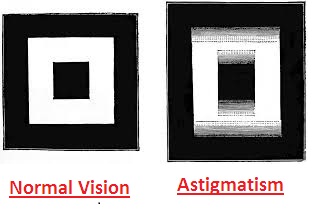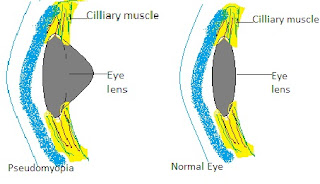Astigmatism
What is Astigmastim ?
Astigmatism is an eye condition where there is a curved flap in your eye's cornea or focal point. It might affect one eye or both eyes. In an ideal eye without any indications of the condition, the cornea and focal center are both totally smooth and bended similarly every which way. Being smooth and totally bended similarly every which way is the thing that assists with centering the light beams onto the retina, which is situated in the rear of your eye.
When you have astigmatism your doctor will prescribe you cylindrical power lens to use for your eye. You should always use lens glass for such cases because you may get back your old correct vision(for lower power e.g. less than +/- 2 D) using glass.
refractive errors – either nearsightedness or hyperopia . It's very common to have both myopia and astigmatism.This is called nearsighted astigmatism. This case of myopia astigmatism, the ebb and flow in the two directions cause the light to center before the retina.
When the cornea and additionally focal point isn't smooth or similarly bended it causes issues in light of the fact that the beams of light aren't appropriately being refracted. There are really different kinds of astigmatism. When there is an unpredictable state of the cornea, it is known as "corneal astigmatism.
However, at whatever point the state of your eye's focal point is misaligned, it is known as "lenticular astigmatism."
Notwithstanding which kind of astigmatism an individual has, they will see an adjustment in their visual perception; regularly both close and far items will seem hazy . A few items will show up excessively tall, excessively short, excessively wide, or excessively dainty. A grown-up is generally ready to tell when their vision is diminishing or encountering issues and by then look for clinical thoughtfulness regarding right the issue at the earliest opportunity. Shockingly, small kids may not know about anything incorrectly which could prompt a large group of issues, for example, social issues and digital learning improvement. As a parent or watchman, you should try to have your kid's eyes inspected in any event once per year. Usually an individual may really be brought into the world with astigmatism; in this manner, the condition will essentially be typical to the children.
Astigmatism may likewise happen with other eye conditions related with refractive error. Partial blindness (nearsightedness) happens when a cornea is curved extreme or when an eye is strangely long. Rather than concentrating on the retina, light is engaged before the retina coming about in far away items looking hazy. Farsightedness (hyperopia) is the point at which a cornea isn't sufficiently bend or the eye is unusually short. This is the specific inverse of partial blindness. With farsightedness, close by objects appear to be foggy.
On the off chance that we separate the significance of the word, the "a-" toward the starting signifies "without" and - disgrace" signifies "point.Astigmatism is a refractive that shields light from coming into center at a solitary point around the retina (the retina is a significant structure inside the eye that demonstrations like a projector screen). Along these lines, to follow the relationship, having astigmatism implies the "projector" is out of core interest. Much of the time, astigmatism isn't identified with eye sickness or eye well being and can be treated with indistinguishable strategies from nearsightedness (partial blindness) and hyperopic (farsightedness).
Cause
There are two reasons for astigmatism: corneal and lenticular.
The cornea is the unmistakable arch molded structure at the front of the eye. At the point when light enters the eye, the cornea is the absolute first surface in our eyes to center or curve the light. Corneal astigmatism happens when the cornea is certifiably not a flawlessly circular shape, and along these lines, the light is twisted unevenly. After the light goes through the cornea, it is likewise engaged by a subsequent structure - the crystalline focal point (regular focal point inside the eye, which we are brought into the world with). Lenticular astigmatism is an aftereffect of an unpredictable state of the crystalline focal point, which can likewise make the light be centered unevenly onto the retina.
Until further notice, let us center our conversation around the more typical reason for unfocused or hazy vision – corneal astigmatism. At the point when the cornea is round fit as a fiddle – like the state of a ball – it will cause light that enters the eye through any piece of the cornea to be centered equally, prompting a solitary point on the retina. On the off chance that the corneal ebb and flow isn't circular, in any case, light is centered unevenly, contingent upon where it goes through the cornea. A cornea with astigmatism is bended more like a football than a ball – has a more drawn out (or compliment) bend start to finish and a shorter (or more extreme) bend from side to side. Most corneas are really like this shape, with a more extreme shape one way and a compliment shape toward another path. The measure of distinction between the arches of these two headings is known as the chamber power (how much astigmatism an individual has).
If you use to read or work for a long time and your eye focus inclined at any severe angle with the book surface or computer screen your cornea will tend to be curved in this angle .As a result cylindrical power will be generated on the same axis in your eye cornea. This phenomena is very common nowadays.








Comments
Post a Comment